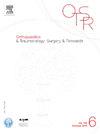A nine-year retrospective study of bacterial epidemiology and culture optimization in four orthopaedic surgery departments
IF 2.2
3区 医学
Q2 ORTHOPEDICS
引用次数: 0
Abstract
Background
Management of device-associated bone and joint infections combines surgical treatment and antibiotic therapy. Immediate postoperative broad-spectrum empiric treatment is often recommended pending complete microbiology results. The probabilistic antibiotics often used are not harmless, and expose the patient to the selection of resistant bacteria and changes in bacterial ecology within the healthcare units. The aim of this study was to answer the following questions: (1) Have the pathogenic bacteria isolated in osteoarticular infections and/or their antibiotic susceptibility profile changed over a 9-year period at our center, with possible implications for antibiotic therapy protocols? (2) Is there a way to optimize the incubation time for microbiological cultures while still being acceptable for slow growing pathogens?
Hypothesis
Our hypothesis was that no difference in microbial epidemiology and antibiotic resistance rates would be found over this 9-year period, confirming antibiotic protocols.
Materials and methods
We conducted a retrospective study describing a nine-year bacterial epidemiology in four traumatology and orthopedic surgery departments. Bacteria identified, site of infection, and antibiotic resistance were evaluated. Antibiotics for use in probabilistic protocols and after documentation of infection were selected for follow-up. Bacterial species were isolated after a maximum incubation period of 15 days up to 2020, and 10 days from 2021 with the addition of a solid culture medium that promotes anaerobic bacterial growth.
Results
Of the 648 clinical situations, 824 bacteria were identified. Gram-positive cocci accounted for 61.4% (506/824) of the strains, including 291/824 (35.3%) Staphylococcus aureus and 136/824 (16.5%) coagulase-negative staphylococci. For the latter, fluoroquinolone resistance remained stable at 7.3% (18/291 (p = 0.086)) and 22.8% (34/136 (p = 0.432)), respectively. Resistance to rifampicin was also stable for Staphylococcus aureus (1.2%,4/291 (p = 0.486)) and for coagulase-negative staphylococci (10.7%, 15/136 (p = 0.596)). Enterobacteriaceae accounted for 148/824 (18.0%) of identifications and were more resistant to piperacillin/tazobactam (15.1%, 24/148) than to cefepime (5.6%,9/148 (p = 0.006)). There was no significant difference between the 15-day and 10-day culture protocols in the proportion of anaerobic bacteria isolated from shoulder (p = 0.721), hip and knee (p = 0.530) prosthesis infections and spinal device-associated infections (p = 0.373). A microbiological diagnosis was made within five days using the 10-day culture protocol in 333/344 (96.8%) cases.
Discussion
The increase in Cutibacterium acnes isolates is mainly explained by the increased number of patients recruited for shoulder arthroplasty. No change in antibiotic resistance was observed in our retrospective study. This is probably related to the use of some precautions when prescribing antibiotic therapy. For gram-negative bacilli, cefepime is the beta-lactam of choice for probabilistic treatment when combined with an antibiotic that is particularly effective against methicillin-resistant staphylococci. An incubation period limited to 10 days seems to be sufficient for the culture of slow-growing organisms, as epidemiological analysis has not shown any negative effects.
Level of evidence
Level IV. Retrospective cohort study.
4个骨科9年细菌流行病学及培养优化回顾性研究。
背景:器械相关骨和关节感染的治疗结合手术治疗和抗生素治疗。通常建议术后立即进行广谱经验性治疗,等待完整的微生物学结果。通常使用的概率抗生素并非无害,并使患者暴露于耐药细菌的选择和卫生保健单位内细菌生态的变化。本研究的目的是回答以下问题:1)在我们中心的9年期间,骨关节感染中分离的致病菌和/或其抗生素敏感性谱是否发生了变化,这可能对抗生素治疗方案产生影响?2)是否有一种方法可以优化微生物培养的孵育时间,同时仍然可以接受缓慢生长的病原体?假设:我们的假设是,在这9年期间,微生物流行病学和抗生素耐药率没有发现差异,证实了抗生素方案。材料和方法:我们进行了一项回顾性研究,描述了四个创伤外科和骨科9年的细菌流行病学。评估鉴定出的细菌、感染部位和抗生素耐药性。选择在概率方案和感染记录后使用的抗生素进行随访。细菌物种在最长潜伏期为15天后分离到2020年,从2021年开始10天,并添加促进厌氧细菌生长的固体培养基。结果:648例临床病例中,检出细菌824株。革兰氏阳性球菌占61.4%(506/824),其中金黄色葡萄球菌291/824(35.3%),凝固酶阴性葡萄球菌136/824(16.5%)。后者对氟喹诺酮类药物的耐药性稳定在7.3% (18/291 (p = 0.086))和22.8% (34/136 (p = 0.432))。金黄色葡萄球菌(1.2%,4/291 (p = 0.486))和凝固酶阴性葡萄球菌(10.7%,15/136 (p = 0.596))对利福平的耐药性也很稳定。肠杆菌科占鉴定总数的148/824(18.0%),对哌拉西林/他唑巴坦(15.1%,24/148)的耐药率高于对头孢吡肟(5.6%,9/148 (p = 0.006))的耐药率。在肩部(p = 0.721)、髋关节和膝关节(p = 0.530)假体感染和脊柱器械相关感染(p = 0.373)中分离的厌氧菌比例在15天培养方案和10天培养方案之间无显著差异。其中333/344例(96.8%)采用10天培养方案,在5天内进行微生物学诊断。讨论:痤疮表皮杆菌分离株的增加主要是由于接受肩关节置换术的患者数量的增加。在我们的回顾性研究中未观察到抗生素耐药性的变化。这可能与开抗生素治疗处方时采取的一些预防措施有关。对于革兰氏阴性杆菌,当与一种对甲氧西林耐药葡萄球菌特别有效的抗生素联合使用时,头孢吡肟是β -内酰胺的概率治疗选择。10天的潜伏期似乎足以培养生长缓慢的生物体,因为流行病学分析没有显示出任何负面影响。证据等级:四级,回顾性队列研究。
本文章由计算机程序翻译,如有差异,请以英文原文为准。
求助全文
约1分钟内获得全文
求助全文
来源期刊
CiteScore
5.10
自引率
26.10%
发文量
329
审稿时长
12.5 weeks
期刊介绍:
Orthopaedics & Traumatology: Surgery & Research (OTSR) publishes original scientific work in English related to all domains of orthopaedics. Original articles, Reviews, Technical notes and Concise follow-up of a former OTSR study are published in English in electronic form only and indexed in the main international databases.

 求助内容:
求助内容: 应助结果提醒方式:
应助结果提醒方式:


